Some daily events in the changing sky for May 1 – 9.
Friday, May 1
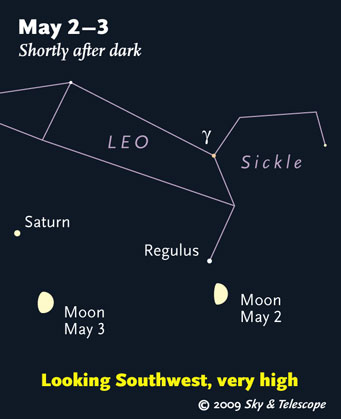
The Moon shines under Regulus on May 2nd and Saturn on May 3rd. These scenes are always drawn for the middle of North America. European observers: move each Moon symbol a quarter of the way toward the one for the previous date. In the Far East, move it halfway. (For clarity, the Moon is shown three times actual size.)
Sky & Telescope diagram
Saturday, May 2
Sunday, May 3
Monday, May 4
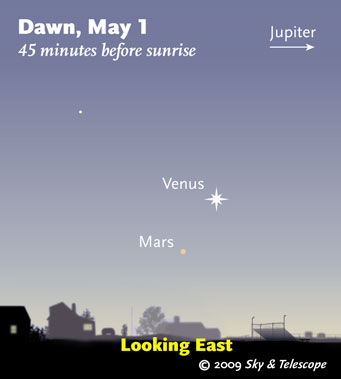
Venus is only about 5° from faint Mars low in the eastern dawn all this week. (The visibility of Mars in bright twilight is exaggerated here.)
Sky & Telescope diagram
Tuesday, May 5
Wednesday, May 6
Thursday, May 7
Friday, May 8
Saturday, May 9
Want to become a better amateur astronomer? Learn your way around the constellations. They're the key to locating everything fainter and deeper to hunt with binoculars or a telescope. For an easy-to-use constellation guide covering the whole evening sky, use the big monthly map in each issue of Sky & Telescope, the essential magazine of astronomy. Or download our free Getting Started in Astronomy booklet (which only has bimonthly maps).
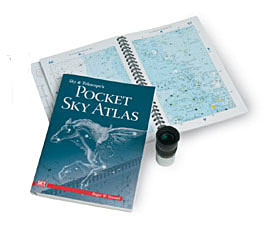
The Pocket Sky Atlas plots 30,796 stars to magnitude 7.6 — which may sound like a lot, but that's less than one star in an entire telescopic field of view, on average. By comparison, Sky Atlas 2000.0 plots 81,312 stars to magnitude 8.5, typically one or two stars per telescopic field. Both atlases include many hundreds of deep-sky targets — galaxies, star clusters, and nebulae — to hunt among the stars.
Sky & Telescope
Once you get a telescope, to put it to good use you'll need a detailed, large-scale sky atlas (set of charts; the standards are Sky Atlas 2000.0 or the smaller Pocket Sky Atlas) and good deep-sky guidebooks (such as Sky Atlas 2000.0 Companion by Strong and Sinnott, the more detailed and descriptive Night Sky Observer's Guide by Kepple and Sanner, or the classic Burnham's Celestial Handbook). Read how to use them effectively.
Can a computerized telescope take their place? I don't think so — not for beginners, anyway, and especially not on mounts that are less than top-quality mechanically. As Terence Dickinson and Alan Dyer say in their Backyard Astronomer's Guide, "A full appreciation of the universe cannot come without developing the skills to find things in the sky and understanding how the sky works. This knowledge comes only by spending time under the stars with star maps in hand and a curious mind." Without these, they note, "the sky never becomes a friendly place."
More beginners' tips: "How to Start Right in Astronomy".
This Week's Planet Roundup
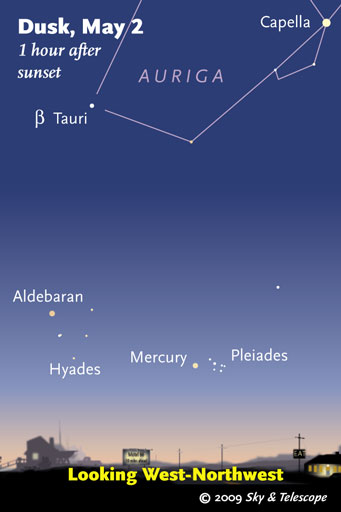
By May 1st and 2nd, the Pleiades slide down to pose directly to Mercury's right. Don't confuse Mercury with Aldebaran, a little higher.
Sky & Telescope diagram
Mercury fades rapidly this week (from magnitude +1 to +3) and starts dropping down into the sunset. Look for it early in the week low in the west-northwest about an hour after sunset. As darkness deepens, look for the Pleiades just to its right, as shown here.
Venus (magnitude –4.7) shines brightly low in the east during dawn. Don't confuse it with Jupiter, higher and far to the right in the southeast. In a telescope, Venus is a thickening and shrinking crescent. The best telescopic views come in full early-morning daylight, when Venus is higher in steadier air.
Mars (only magnitude +1.2) remains 5° or 6° lower left of Venus all week. Bring binoculars; Mars is 230 times fainter than Venus! Mars is beginning a long, slow apparition that will bring it to opposition on January 29, 2010.
Jupiter (magnitude –2.2, in Capricornus) shines brightly in the southeast before and during dawn.
Saturn (magnitude +0.8, in Leo) is highest in the south in early evening and moves to the southwest later. Regulus, not quite as bright, sparkles 15° to its right at dusk, and to its lower right later.
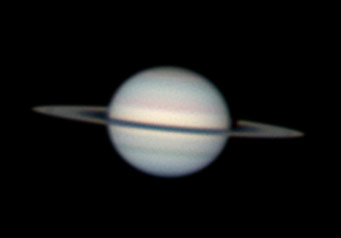
Saturn on the evening of April 29th, imaged through poor seeing by Sean Walker.
S&T: Sean Walker
In a telescope, Saturn's rings appear 4° from edge on, their widest this year. They'll close to exactly edge-on September 4th, when, unfortunately, Saturn will be out of sight practically in conjunction with the Sun.
Uranus (6th magnitude) is low in the sunrise glow, in the background of Venus — and 17,000 times fainter.
Neptune (8th magnitude) is the background of Jupiter — and 11,000 times fainter.
Pluto (14th magnitude, in northwestern Sagittarius) is highest in the south before the first light of dawn. It's 250 times fainter than even Neptune.
All descriptions that relate to your horizon or zenith — including the words up, down, right, and left — are written for the world's mid-northern latitudes. Descriptions that also depend on longitude (mainly Moon positions) are for North America. Eastern Daylight Time (EDT) equals Universal Time (also known as UT, UTC, or GMT) minus 4 hours.
To be sure to get the current Sky at a Glance, bookmark this URL:
http://SkyandTelescope.com/observing/ataglance?1=1
If pictures fail to load, refresh the page. If they still fail to load, change the 1 at the end of the URL to any other character and try again.
 0
0
Comments
You must be logged in to post a comment.